Bordeaux has been transformed in the last few decades by Alain Juppé, mayor since 1995, who ordered the cars to underground car parks, cleaned the grime off the stone buildings, and turned the city into a gorgeous place for pedestrians and visitors. And as it is a center of the wine trade, a place for wine tastings and trips to vineyards, and a trendy cultural center, it’s time you visited Bordeaux!
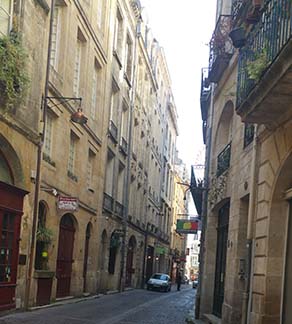
I knew Bordeaux was a city of wine, but I didn‘t expect it to also be a place of such charm. Then I learned there was an historical connection. I got a taste of it in a walk through the historic center with Christine Birem, a very knowledgeable guide, who took us through the city from medieval times through the 15th to 18th centuries and its very modern present.
Start out by understanding that Bordeaux is a port, a trading city. Christine explained that Bord eaux means the bank of the waters and Eaux bourde means marshland. The first port of Bordeaux was on an estuary of the Garonne River at a place which is now land. But eventually, the port moved to the Garonne.
Bordeaux was a fortress with ramparts. In the oldest part of the city, houses were built in the 13th and 14th centuries. Its first houses were of the wine merchants. Ships stopped there, off-loading spices, coffee and tea and taking on wine barrels.
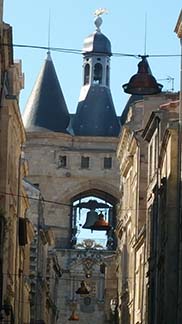
Some of the old structures date to when a French king decided to construct elegant buildings for the wealthy business people of the wine trade. Some old buildings have wood on their outer walls; some have sculpted masks.
Christine pointed out a house with symbols of the Far East, where the owner traded. When houses sit on small curved streets, that means that lane existed in the Middle Ages. She explained, “They had no feeling of going straight, they just constructed where they wanted to construct.”
In some buildings, artisans made ropes for ships. Or they were the abodes of chandlers, the retail dealers who provided supplies and equipment for ships. The river is ever present: when on a house you see a vase with water flowing out, that represents the River Garonne. Now the streets have other purposes. Rue des Faussets, where houses seem to lean into the street, is popular for its restaurants.
The street of silversmiths includes buildings from the 15th century. In the windows you see the stone cross, typical for the Middle Ages. Now, the silversmiths make cups and medals for commemorations. Rue de la vache is the street through which cattle were brought into the city.
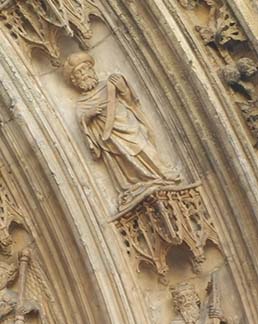
My favorite historic monument place is the 15th century Porte Cailhau, the main entrance into Bordeaux. Construction began under King Charles VIII, his coat of arms is on the arch. Cailhau was the name of a mayor of the era. The bell on the tower was rung in case of fire. As the houses were mostly of wood, fires were frequent. Today it rings every first Sunday of the month.
From the other side we see the 18th century. On the left side is a small window, a prison window. The prison was the hotel of the golden lion. When the ship chandlers needed strong sailors, they came here, gave authorities some money – “Here‘s a strong man, I need him, I give you 20.” Those prisoners went on ships as sailors. Impressed seamen.
Christine showed us something special about the 15th century Eglise Saint-Pierre (all but the choir was rebuilt in the 19th). Look at the sculpted figures on the right side of the arch. The third from the bottom is a pilgrim – we know that from his hat with the sign of pilgrims, a shell with waves of the river. In one hand is a paper roll, and the finger of the other points south, the direction of the pilgrimage destination, Santiago de Campostela.
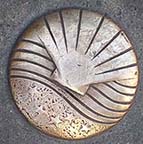 And we notice there and on numerous streets, the small round brass plates indicate the pilgrims‘ road. The famous Rue St James (pronounced szham-es) is still the way to Santiago. There‘s a new pilgrims house, which costs 13 euros to stay overnight. It has small rooms with two beds, furnished with paper sheets! You need a pilgrim‘s pass, which is complicated to get.
And we notice there and on numerous streets, the small round brass plates indicate the pilgrims‘ road. The famous Rue St James (pronounced szham-es) is still the way to Santiago. There‘s a new pilgrims house, which costs 13 euros to stay overnight. It has small rooms with two beds, furnished with paper sheets! You need a pilgrim‘s pass, which is complicated to get.
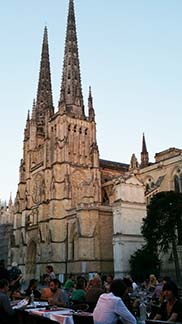
Going back in time again, the cathedral was once a 12th century Romanesque church. It was enlarged in following centuries, till by the 15th it had become flamboyantly gothic. The cathedral square had a statue of the king on horseback, but that was removed at the time of the French Revolution. Another revolution was made by Mayor Juppé. The square once had been a parking place, and the church was surrounded by car traffic. Now that is all gone, and the cars are replaced by terrace cafes. Cars park underground and people ride trams.
Houses had gables in the 16th century, and in the centuries to follow, roofs became flatter. We saw one with an iron rail with a medallion of the house owner. There‘s a reason for the wrought iron on buildings. Bordeaux had been famous for swords, and when guns put swords out of business, the sword makers turned to creating wrought iron railings. (Swords into plowshares?)
There‘s a plaque at the house of Simon Millanges, who printed essays of the 16th century mayor of Bordeaux, Michel de Montaigne, one of the most significant philosophers of the French Renaissance.
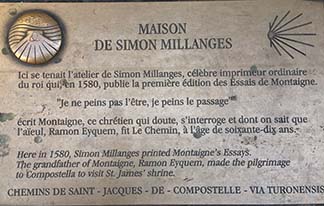
The golden house, la maison dorée, with geometrical ornaments shows the beginning of art deco at the end of the 18th century.
Highlighting another kind of art, the theater is on a large square, a site which the Romans called Burdigala and where they built a temple. Its ruins were discovered by the architect hired to build the theater, which has existed since 1780 in the same style.
For a port, you need a customs house, and the 18th-century building along the Garonne still functions. It‘s on the square of the stock exchange, Place de la Bourse, also 18th century stone. But the magic of that site is across the street, the “water mirror,” set on a quai of the Garonne, which reflects the buildings at the Place de la Bourse.
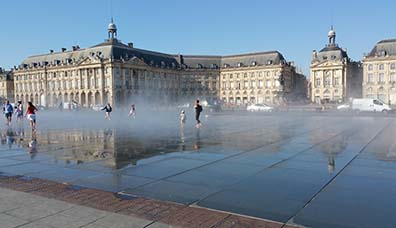
The size of the mirror is 180 meters long, 40 meters wide, 2 centimeters of water deep over a granite base. It was planned as a mirror of the buildings on the stock exchange square. But, there are moments when it stops being a mirror and shoots up in mists. The water disappears and then in a musical rhythm is pushed out by round plates as mist. It was designed ten years ago by landscape artist Michel Corajoud and is listed as a contemporary World Heritage Site by UNESCO. People, kids, love to walk through it. Young people gather there in the evening.
More about fixing up Bordeaux. “We are world cultural heritage,” said Christine. “But before 1998, Bordeaux was black. All the houses in Bordeaux had this color.” They were black from the grime of pollution. Mayor Juppé started cleaning them up. Private owners got subsidies from the government if they put their own money toward the cleaning. And that was tax deductible. Low income people couldn‘t afford it, for the others, it was free. With the pedestrian streets came shops and cafés, which were encouraged to bring life to streets that had been dominated by cars.
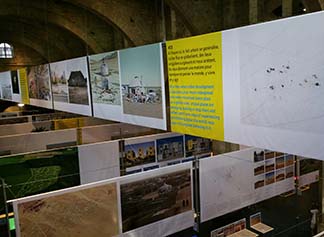
We came across the name Burdigala again, surprised to find it on the boat of a tour company that runs short cruises on the Garonne. There‘s not a lot to see, but we liked viewing the new wine museum from the outside and getting a glimpse of the old wine warehouses north of the historic center. After World War II, the port moved north. The old warehouses are now cafés and boutiques.
From centuries past to century future! I always visit the local modern art museum to see what contemporary artists are doing. The Centre of Contemporary Visual Arts, CAPC (Musée d‘art contemporain), showed that French artists – or at least the museum curators! – are attuned to changing politics – ecology, feminism, movements against racism and world poverty. The major exhibit, taking up the entire ground floor, was called “Constellation.s.”
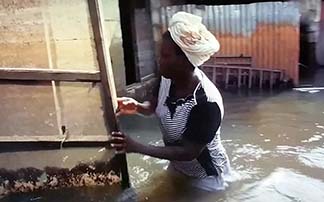
On the theme of architecture, cities and human habitation, it is built of criss-crossing panels reaching high to the ceiling, all of them dealing with phases of human development on this planet. Directed by Francine Fort, and using words like “connectivity,” “empowerment,” “special justice,” it turns global politics into art.
The mayor enjoys the new mood of the square. His office is in a palace for royals finished in 1782. After the revolution, it became the town hall. The walls of the drawing rooms are original.
A highlight of the trip I keep till last. You have to do a wine visit. De rigeuer. It can be at a class or tasting in town (ask the tourism bureau for recommendations) or a visit to a vineyard outside town. The tourism office arranges those, too. There are numerous to choose from, depending on which Bordeaux wine area you want to visit, for example Graves and Sauternes, Médoc and Margaux, Pomerol and Saint-‰milion, and more. Usually, you visit two vineyards with two different denominations in the same area.
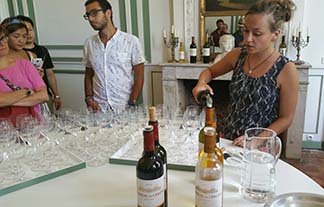
I chose the first because my companion can drink only white wine, but if I had another choice, I would take a trip to Saint-‰milion, since that includes a visit to the medieval village. The trips take 4 or 5 hours, depending on the distance from the city.
A guide on the bus provides background and answers questions. You get a tour of the cellars, a visit to the vines, explanations and, of course, tastings! A tourism office booklet lists them all, and the days they run, some full days with lunch, some half, some evenings.
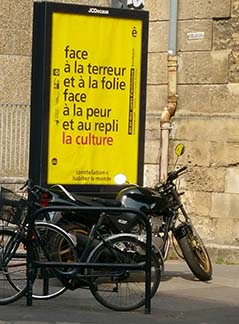
I went to a tasting of Cérons, a sweet white wine in the region south of the city that produces Graves and Sauternes. The wine here is poured by Caroline Perromat at the Chateau de Cérons. We also got a visit to the caves and a look at the vines.
I drink to Bordeaux!
IF YOU GO
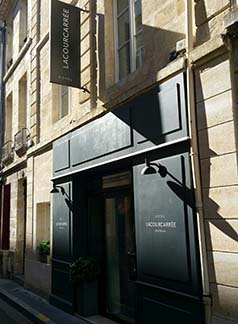
Bordeaux City Pass gets you free or discount admission to museums, monuments, wine tours, local transit and more. 1 day €26, 2 days €33, 3 days €40.
Centre of Contemporary Visual Arts CAPC (Musée d‘art contemporain).
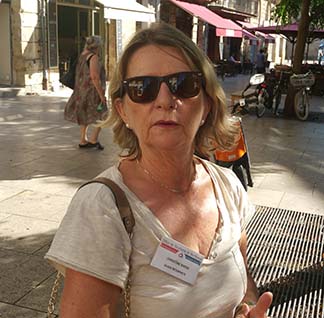
Arc en Rªve exhibit through Sept 25, 2016.
We stayed at La Cour Carrée, a small boutique hotel in a renovated 200-year-old town house perfectly located in the center of the city.
For the Burdigala cruise on the Garonne, meet at Ponton d’Honneur, Quai Richelieu, just south of the water mirror. Book through the tourism office.
Wine tours. Book through the tourism office. And visit Chateau de Cérons.
La Cité du Vin. The new wine museum, 1 Esplanade de Pontac. Never got to see it, the top of my list for next time.
Personal note: as a travel journalist I appreciate that French tourism organization and assistance is the world‘s gold standard! And so was our knowledgeable and attentive guide Christine Birem, with bon courage but perhaps a little épuisée after a near three-hour walk on one of the hottest days of August!
Photos by Lucy Komisar.

